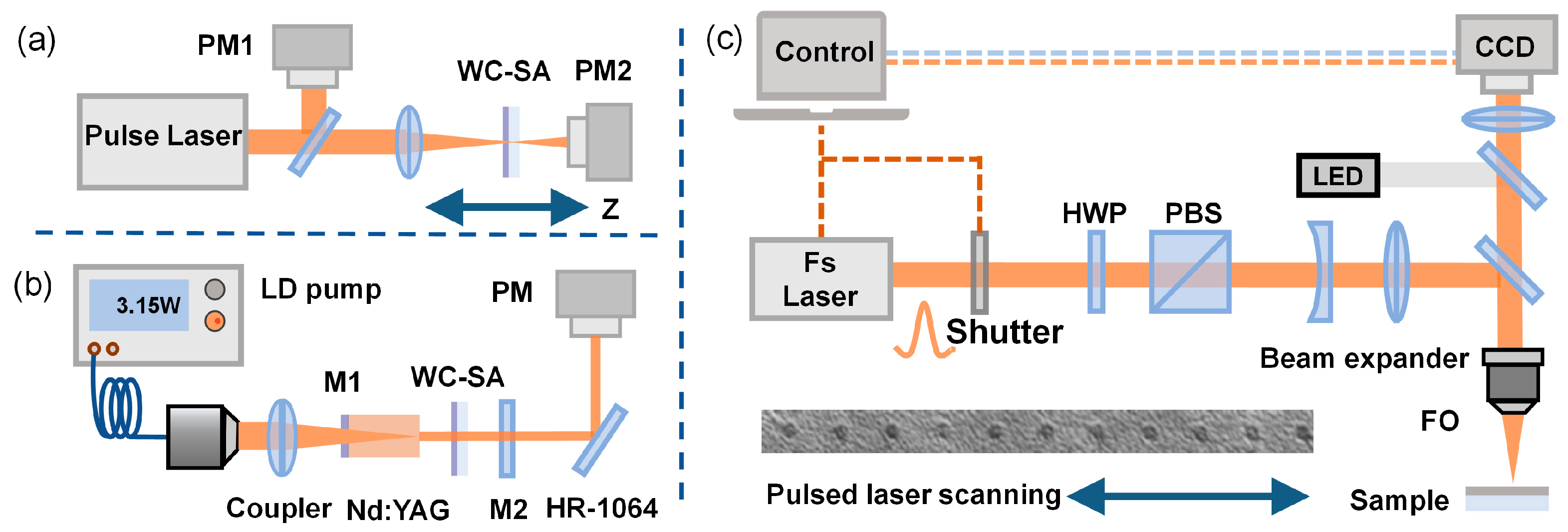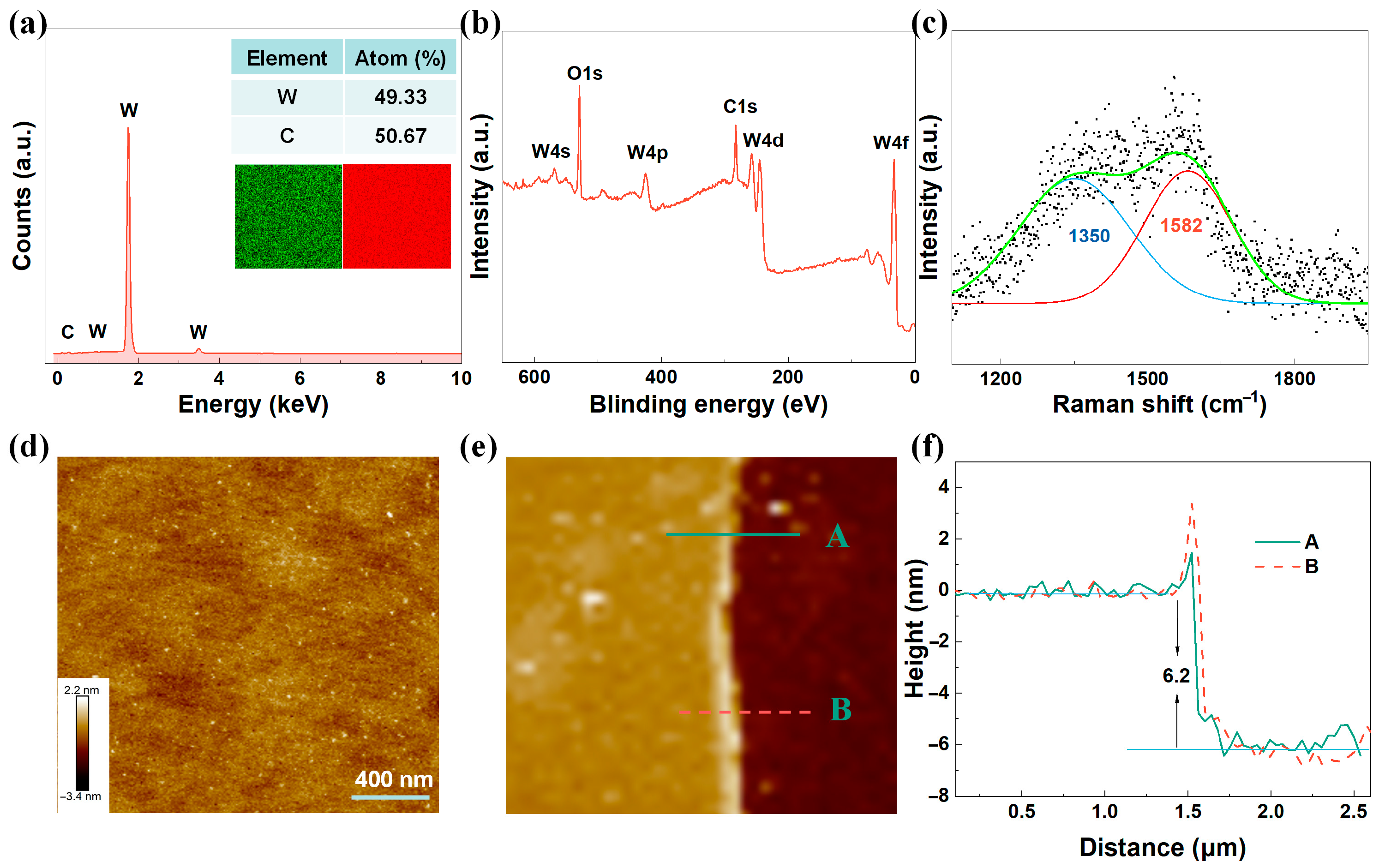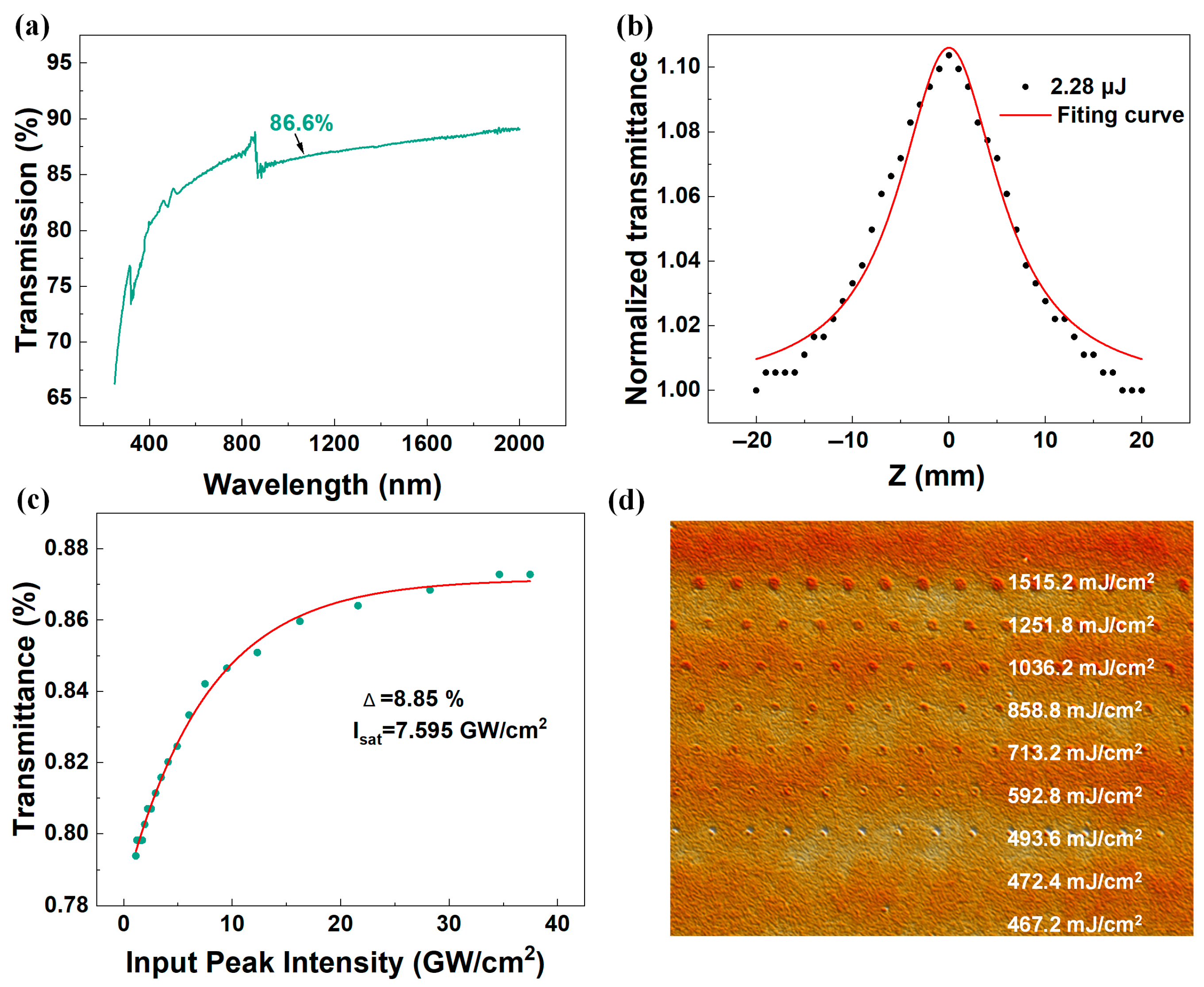Nonlinear Optical Response of Tungsten Carbide Thin Film as Saturable Absorber at 1 μm and Its Application for Passively Q-Switched Nd:YAG Lasers
Abstract
:1. Introduction
2. Experimental Methods
3. Results and Discussions
4. Conclusions
Author Contributions
Funding
Data Availability Statement
Conflicts of Interest
References
- Wu, Z.; Wu, X.; Zhang, Y.; Liu, Y.; Zhang, X.; Yang, C. Effect of nanosecond pulse laser power on welding interface and mechanical properties of AZ31B Mg/6061 Al. Opt. Laser Technol. 2024, 175, 110848. [Google Scholar] [CrossRef]
- Berczeli, M.; Tajti, F.; Juhász, G.; Weltsch, Z. Changing the High Strength Steel Surface Properties with Femtosecond Laser Beam. Opt. Laser Technol. 2024, 174, 110556. [Google Scholar] [CrossRef]
- Zhang, J.; Sun, R.; Ge, Y.; Wang, J.; Wang, Z.; Meng, L.; Deepak, F.L.; Zhang, M.; Yin, P.; Cheng, F. Atomic-scale structure and nonlinear optical absorption of two-dimensional GeS. J. Mater. Sci. Technol. 2024, 187, 188–194. [Google Scholar] [CrossRef]
- Yang, Z.; Yang, Q.; Tian, Y.; Ren, X.; Li, C.; Zu, Y.; Din, S.Z.U.; Gao, L.; Wu, J.; Chen, H. Few-layer Ti3CN MXene for ultrafast photonics applications in visible band. J. Mater. 2023, 9, 44–55. [Google Scholar] [CrossRef]
- Chen, Q.; Lu, S.; Zhang, Y.; Yin, H.; Li, Z.; Zhang, P.; Chen, Z. The passive Q-switched and Q-switched mode-locked Nd: GYAP laser based on a novel Bi2O3 saturable absorber. Opt. Laser Technol. 2024, 174, 110620. [Google Scholar] [CrossRef]
- Wang, F.; Qu, Y.; Lan, D.; Zhang, X.; Cheng, T. VO2 nanoparticles saturable absorbers onto D-shaped fiber for mode-locked operation at 1560 nm band. Opt. Laser Technol. 2022, 151, 108060. [Google Scholar] [CrossRef]
- Wang, J.; Li, G.; Liu, S.; Chai, J.; Wang, Y.; Cheng, G.; Zhang, G.; Liu, Y.; Li, X. Nonlinear absorption response of Zirconium Carbide films. ACS Appl. Mater. Interfaces 2023, 15, 3317–3324. [Google Scholar] [CrossRef]
- Polini, R.; Marcucci, A.; D’Ottavi, C.; Nunziante, P.; De Filippis, P.; Marcheselli, G. Toward greener synthesis of WC powders for cemented tungsten carbides manufacturing. ACS Sustain. Chem. Eng. 2021, 9, 8458–8466. [Google Scholar] [CrossRef]
- Rafique, M.; Fu, Q.; Han, J.; Wang, R.; Yao, T.; Wang, X.; Song, B. Tungsten Carbide-Based Materials for Electrocatalytic Water Splitting: A Review. ChemElectroChem 2024, 11, e202300722. [Google Scholar] [CrossRef]
- Li, H.; Wang, W.; Xue, S.; He, J.; Liu, C.; Gao, G.; Di, S.; Wang, S.; Wang, J.; Yu, Z. Superstructure-Assisted Single-Atom Catalysis on Tungsten Carbides for Bifunctional Oxygen Reactions. J. Am. Chem. Soc. 2024, 146, 9124–9133. [Google Scholar] [CrossRef]
- Zheng, W.; Wang, L.; Deng, F.; Giles, S.A.; Prasad, A.K.; Advani, S.G.; Yan, Y.; Vlachos, D.G. Durable and self-hydrating tungsten carbide-based composite polymer electrolyte membrane fuel cells. Nat. Commun. 2017, 8, 418. [Google Scholar] [CrossRef] [PubMed]
- Padmakumar, M.; Dinakaran, D. A review on cryogenic treatment of tungsten carbide (WC-Co) tool material. Mater. Manuf. Processes 2021, 36, 637–659. [Google Scholar] [CrossRef]
- Lan, D.; Cheng, T.; Qu, Y.; Zhang, X.; Yan, X.; Suzuki, T.; Ohishi, Y.; Wang, F. Tungsten carbide nanoparticles as saturable absorber for Q-switched erbium-doped fiber laser. IEEE Photonics Technol. Lett. 2022, 34, 113–116. [Google Scholar] [CrossRef]
- Wang, F.; Lan, D.; Zhao, J.; Qu, Y.; Zhou, X.; Zhang, X.; Cheng, T. Ultrafast fiber lasers at 1560 nm and 1932 nm modulated by WC nanoparticles and d-shaped fibers. Opt. Laser Technol. 2023, 158, 108778. [Google Scholar] [CrossRef]
- Hu, B.; Shi, X.-L.; Cao, T.; Li, M.; Chen, W.; Liu, W.-D.; Lyu, W.; Tesfamichael, T.; Chen, Z.-G. Advances in flexible thermoelectric materials and devices fabricated by magnetron sputtering. Small Sci. 2023, 5, 2300061. [Google Scholar] [CrossRef]
- Teresi, S.; Sebe, N.; Patterson, J.; Frottier, T.; Kandazoglou, A.; Noël, P.; Sgarro, P.; Térébénec, D.; Bernier, N.; Hippert, F. Spin-Orbit Readout Using Thin Films of Topological Insulator Sb2Te3 Deposited by Industrial Magnetron Sputtering. Adv. Funct. Mater. 2023, 33, 2303878. [Google Scholar] [CrossRef]
- Han, X.; Zhang, H.; Jiang, S.; Zhang, C.; Li, D.; Guo, Q.; Gao, J.; Man, B. Improved laser damage threshold of In2Se3 saturable absorber by PVD for high-power mode-locked Er-doped fiber laser. Nanomaterials 2019, 9, 1216. [Google Scholar] [CrossRef]
- Liu, G.; Kuang, D.; Song, L.; Xu, C.; Yan, C. Mechanism in damage variation of nanosecond laser-induced damage of germanium sheets in vacuum. Opt. Laser Technol. 2023, 157, 108663. [Google Scholar] [CrossRef]
- Hussain, S.; Rabani, I.; Vikraman, D.; Feroze, A.; Karuppasamy, K.; Haq, Z.U.; Seo, Y.-S.; Chun, S.-H.; Kim, H.-S.; Jung, J. Hybrid design using carbon nanotubes decorated with Mo2C and W2C nanoparticles for supercapacitors and hydrogen evolution reactions. ACS Sustain. Chem. Eng. 2020, 8, 12248–12259. [Google Scholar] [CrossRef]
- Li, Y.; Wu, X.; Zhang, H.; Zhang, J. Interface designing over WS2/W2C for enhanced hydrogen evolution catalysis. ACS Appl. Energy Mater. 2018, 1, 3377–3384. [Google Scholar] [CrossRef]
- Krasovskii, P.V.; Malinovskaya, O.S.; Samokhin, A.V.; Blagoveshchenskiy, Y.V.; Kazakov, V.A.; Ashmarin, A.A. XPS study of surface chemistry of tungsten carbides nanopowders produced through DC thermal plasma/hydrogen annealing process. Appl. Surf. Sci. 2015, 339, 46–54. [Google Scholar] [CrossRef]
- Ferrari, A.C.; Robertson, J. Interpretation of Raman spectra of disordered and amorphous carbon. Phys. Rev. B 2000, 61, 14095. [Google Scholar] [CrossRef]
- Ferrari, A.C.; Robertson, J. Raman spectroscopy of amorphous, nanostructured, diamond–like carbon, and nanodiamond. S.A. Math. Phys. Eng. Sci. 2004, 362, 2477–2512. [Google Scholar] [CrossRef]
- Guo, J.; Huang, D.; Zhang, Y.; Yao, H.; Wang, Y.; Zhang, F.; Wang, R.; Ge, Y.; Song, Y.; Guo, Z. 2D GeP as a novel broadband nonlinear optical material for ultrafast photonics. Laser Photonics Rev. 2019, 13, 1900123. [Google Scholar] [CrossRef]
- Gao, L.; Chen, H.; Zhang, F.; Mei, S.; Zhang, Y.; Bao, W.; Ma, C.; Yin, P.; Guo, J.; Jiang, X. Ultrafast relaxation dynamics and nonlinear response of few-layer niobium carbide MXene. Small Methods 2020, 4, 2000250. [Google Scholar] [CrossRef]
- Shang, X.; Zhang, Y.; Li, T.; Zhang, H.; Zou, X.; Wageh, S.; Al-Ghamdi, A.A.; Zhang, H.; Si, S.; Li, D. Nonlinear optical response of niobium telluride and its application for demonstrating pulsed fiber lasers. J. Mater. 2024, 10, 355–365. [Google Scholar] [CrossRef]
- Liu, J.; Yang, F.; Lu, J.; Ye, S.; Guo, H.; Nie, H.; Zhang, J.; He, J.; Zhang, B.; Ni, Z. High output mode-locked laser empowered by defect regulation in 2D Bi2O2Se saturable absorber. Nat. Commun. 2022, 13, 3855. [Google Scholar] [CrossRef] [PubMed]
- Pan, H.; Chu, H.; Li, Y.; Pan, Z.; Zhao, S.; Zhao, W.; Huang, W.; Li, D. Bismuthene quantum dots integrated D-shaped fiber as saturable absorber for multi-type soliton fiber lasers. J. Mater. 2023, 9, 183–190. [Google Scholar] [CrossRef]
- Tinglun, X.; Xiaoyu, W.; Zhenni, O.; Jieling, G.; Dunlu, S.; Huaixi, C.; Xi, W.; Ke, C.; Yuzong, G. Peak-power of 25 W passively Q-switched ~2.8 μm Er:YAP bulk laser based on a reflective TaSe2 saturable absorber mirror. Opt. Laser Technol. 2024, 169, 110051. [Google Scholar]
- Feng, X.Y.; Ding, B.Y.; Liang, W.Y.; Zhang, L.; Liu, Q. MXene Ti3C2Tx Absorber for a 1.06 μm Passively Q-Switched Ceramic Laser. Laser Phys. Lett. 2018, 15, 085805. [Google Scholar] [CrossRef]
- Su, X.; Zhang, B.; Wang, Y.; Li, J.; Chen, Z. Broadband Rhenium Disulfide Optical Modulator for Solid-State Lasers. Photonics Res. 2018, 6, 498–505. [Google Scholar] [CrossRef]
- Wang, J.; Xie, L.; Wang, Y.; Li, H.; Zhang, X. High-Damage Vanadium Pentoxide Film Saturable Absorber for Sub-Nanosecond Nd:YAG Lasers. Infrared Phys. Technol. 2023, 129, 104580. [Google Scholar] [CrossRef]
- Wang, J.; Xie, L.; Liu, J.; Li, Y.; Zhang, X. Nonlinear Optical Response of Thermally Stable Perovskite for Near-Infrared Optical Modulator. J. Mater. 2025, 11, 100858. [Google Scholar] [CrossRef]
- Wang, J.; Chen, Z.; Wang, Y.; Li, H.; Zhang, X. Molybdenum Disulfide Film Saturable Absorber Based on Sol–Gel Glass and Spin-Coating Used in High-Power Q-Switched Nd:YAG Laser. ACS Appl. Mater. Interfaces 2020, 12, 9404–9408. [Google Scholar] [CrossRef] [PubMed]





| 2D Material | Laser Type | ΔT (%) | ISA | Repetition Rate (kHz) | Pulse Duration (ns) | Average Output Power (mW) | Ref. |
|---|---|---|---|---|---|---|---|
| Ti3C2Tx | Nd:YAG | 36.7 | 1.07 μJ/cm2 | 186 | 359 | 94.8 | [30] |
| ZrC | Nd:YAG | 6.9 | 48.4 MW/cm2 | 596 | 78 | 121 | [7] |
| ReS2 | Nd:YAG | 5.2 | 21.5 μJ/cm2 | 644 | 139 | 120 | [31] |
| V2O5 | Nd:YAG | 21.8 | 329.8 kW/cm2 | 379 | 59 | 86 | [32] |
| Cs0.15FA0.85PbI2.85Br0.15 | Nd:YAG | 15.1 | 6.14 MW/cm2 | 381.2 | 166 | 338 | [33] |
| MoS2/SiO2 | Nd:YAG | 8.41 | 9.35 MW/cm2 | 1809 | 132 | - | [34] |
| WC | Nd:YAG | 8.85 | 7.595 GW/cm2 | 214 | 684 | 185 | Our work |
Disclaimer/Publisher’s Note: The statements, opinions and data contained in all publications are solely those of the individual author(s) and contributor(s) and not of MDPI and/or the editor(s). MDPI and/or the editor(s) disclaim responsibility for any injury to people or property resulting from any ideas, methods, instructions or products referred to in the content. |
© 2025 by the authors. Licensee MDPI, Basel, Switzerland. This article is an open access article distributed under the terms and conditions of the Creative Commons Attribution (CC BY) license (https://creativecommons.org/licenses/by/4.0/).
Share and Cite
Zhang, Z.; Xie, L.; Liu, Z.; Wang, X.; Wang, J.; Zhang, G.; Zhang, X.; Miao, Z.; Cheng, G. Nonlinear Optical Response of Tungsten Carbide Thin Film as Saturable Absorber at 1 μm and Its Application for Passively Q-Switched Nd:YAG Lasers. Nanomaterials 2025, 15, 605. https://doi.org/10.3390/nano15080605
Zhang Z, Xie L, Liu Z, Wang X, Wang J, Zhang G, Zhang X, Miao Z, Cheng G. Nonlinear Optical Response of Tungsten Carbide Thin Film as Saturable Absorber at 1 μm and Its Application for Passively Q-Switched Nd:YAG Lasers. Nanomaterials. 2025; 15(8):605. https://doi.org/10.3390/nano15080605
Chicago/Turabian StyleZhang, Zhonglin, Liang Xie, Zhengwu Liu, Xu Wang, Jiang Wang, Guodong Zhang, Xinwei Zhang, Zongcheng Miao, and Guanghua Cheng. 2025. "Nonlinear Optical Response of Tungsten Carbide Thin Film as Saturable Absorber at 1 μm and Its Application for Passively Q-Switched Nd:YAG Lasers" Nanomaterials 15, no. 8: 605. https://doi.org/10.3390/nano15080605
APA StyleZhang, Z., Xie, L., Liu, Z., Wang, X., Wang, J., Zhang, G., Zhang, X., Miao, Z., & Cheng, G. (2025). Nonlinear Optical Response of Tungsten Carbide Thin Film as Saturable Absorber at 1 μm and Its Application for Passively Q-Switched Nd:YAG Lasers. Nanomaterials, 15(8), 605. https://doi.org/10.3390/nano15080605





